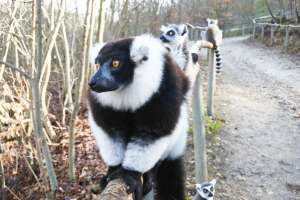
2015-2016 Activity Report
Long-term field studies and biodiversity conservation
in protected forests of Madagascar
Shinichiro ICHINO
Center for African Area Studies Post-doctoral researcher
Kyoto University
1. Research themes
Conservation of biodiversity in the African tropical forest has come to be considered a global environmental issue. Madagascar has unique flora and fauna with high rates of endemism. In spite of the uniqueness, it is estimated that more than 90% of natural forest of Madagascar has disappeared and most animals and plants are facing a high risk of extinction. Thus, Madagascar is considered to be one of the biodiversity hotspots where high-priority conservation efforts are required.
Despite the current expansion of Madagascar’s protected forest areas, the most forests already have been fragmented and only small forest fragments still remain in some area of Madagascar. In such area, conserving the remaining small forests as many as possible is more realistic conservation strategy to achieve high biodiversity as a whole. Although small forest has risk of extinction of some specific taxa, it has also some advantages that management can protect the forest strictly and react quickly to any situation. In order to achieve biodiversity conservation by the remaining small forests, it is required to clarify the potential risk and the potential value of small forests in the area.
In this study, I focus on relations between long-term field research and biodiversity conservation. In field primatology and field ecology, long-term field studies have been conducted in several research sites in Madagascar and the activity is expected to contribute to biodiversity conservation in the area. In spite of such expectation, we still have not clarified what kind of activities and scientific findings by the long-term field research contribute to biodiversity conservation in the area. Thus, clarification of the relations and the background situation in each research site may help to understand the way to enhance values of small forest for biodiversity conservation.
I examine cases of the following three Malagasy forests where long-term field studies for more than 20 years have been conducted and clarify the roles and the problems of the long-term field study and other related activities on biodiversity conservation of the forests.
1) Berenty Reserve (Southern Madagascar, semi-deciduous gallery forest)
2) Ankarafantsika National Park (Northwestern Madagascar, deciduous dry forest)
3) Kirindy Forest (Southwestern Madagascar, deciduous dry forest)
2. Dispatch details
(1) Madagascar (February 9 – March 17, 2016)
I visited my main study site, Berenty Reserve and had several meetings with reserve owner and local NGO staff. I also conducted behavioral observation of lemurs, a survey of plants and animals in the reserve, and a field interview survey on local knowledges on plants and animals.
(2) Germany (March 19- May 1, 2016)
After the fieldwork in Madagascar, I moved to Göttingen (Lower Saxony) in which I belonged to behavioral ecology and sociobiology/ Anthropology Unit of the German Primate Center (DPZ: Deutches Primatenzentrum) as a visiting researcher. I started a collaborative research project on female competition of group-living lemurs with Professor Peter Kappeler and a senior scientist Dr. Claudia Fichtel.
3. Particularly noteworthy professional and personal experiences during my dispatch
In 2016, Southern Madagascar was suffering from extraordinary drought during the dispatch period (February and March). Although the period corresponds to rainy season of southern Madagascar and water level of Mandrare River is usually high in normal year, the river was almost dried up during the period. I realized that climate change is a considerable factor in biodiversity conservation in this area.
I also observed a forest disappearance right next to the southern boundary of the reserve. A part of Berenty (Anaramalangy forest) had connected to the Kaleta Reserve owned by other owner. In March 2016, I observed that the forest has completely disappeared (Photo 1). According to local people, all trees have been cut for firewood and charcoal after closing the reserve. After I returned to Japan, I looked over aerial photographs in the region and found that the forest remained in 2011 and disappeared in 2016. Thus, the connecting forest disappeared in last 5 years. I strongly realized that forest disappearance is ongoing in this area.
In Germany, I had an opportunity to visit Affenwald in Straussberg (Sondershausen, Thuringia) which is a large outdoor enclosure for ring-tailed lemurs (Lemur catta) and black-and-white ruffed lemurs (Varecia variegata) (Photo 2). In the park, some students and researchers of German Primate Center are conducting some experimental research on social learning. It was nice experience to see the place.
Photo 1. Forest disappearance right next to Berenty Reserve
Photo 2. Some lemurs at Affenwald in Straussberg
4. Achievement of research objectives and areas needing improvement
In Madagascar, I had a meeting with an owner of the Berenty Reserve, Ms. Claire Foulon and could explain my research project, while I could not have a meeting with researchers of Antananarivo University since a main collaborative researcher; Professor Rakotomanana had been invited to our center and been staying in Japan during the same period. Instead, I had got in touch with Professor Rakotomanana and his colleague, Professor Felix Rakotondraparany by email.
In Germany, I could discuss with Professor Kappeler and Dr. Fichtel and decided methods and schedule of the analysis for the collaborative research project.
5. Challenges and objectives for the next dispatch
I will start new collaborative research with researchers of Antananarivo University from next visit to Madagascar. Also I will talk with them about new Memorandum of Understanding with our Center.











